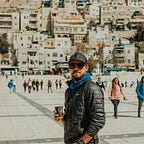One Night in Tangier
First Impressions of a Reopened Morocco
I’m listening to Zach Bryan as we land in Morocco. Maybe the music doesn’t fit the environment, but it’s a fun juxtaposition to the chaos that I know is coming when the plane touches down.
The last four days have been a blur of airports and security screenings. We flew from Lima to Atlanta and spent two days with friends, restocking on toiletries and telling stories about Medellín and Machu Picchu. Then it was back to the international departures terminal, with an overnight flight to Heathrow, a mad dash out of the airport for a COVID screening in a sidewalk clinic, and a connecting flight to Barcelona that we caught with only minutes to spare. The next morning, still reeling from jet lag, we boarded this flight to Morocco, another country I’d dreamed about visiting for as long as I could remember.
The flight touches down and an almost tangible energy fills the plane as everyone on board aches to escape down to the tarmac.
Latin Americans joke that they hate standing in lines, and some even claim they don’t understand the concept, but that’s no comparison for the Middle Eastern disdain for waiting. Any time there’s a queue, you can expect it to inch along at a confused crawl while children run wild and mothers use strollers as blunt force weapons, jockeying for position as if there’s a prize for first place. As soon as the plane stops taxiing, chaos breaks loose as everyone tries to get to the door at the same time.
Somehow we escape the gauntlet of the center aisle and descend onto the tarmac without losing any digits or sustaining too many bruises in the melee of rolling suitcases. The sky is gray and the pavement damp. It’s rained today, and more rain is coming.
While this is my first visit to Morocco, there’s a degree of sameness that exists in all Middle Eastern cities as Westernization creeps in. Men wearing Hugo Boss sneakers and Louis Vuitton messenger bags carry softly clinking bottles of duty-free liquor. Women match headscarves with fur trimmed coats and Balenciagas. Everyone taps ferociously on an iPhone as if they’re Wall Street traders while simultaneously looking bored behind designer sunglasses, naturally worn indoors. Of the maybe one hundred people waiting to pass through customs, I count one man with graying hair and four older women wearing what you’d probably think of as traditional dress.
I quickly learn that everything in Morocco is a process. From hiring a taxi to leave the airport, where it takes three drivers to figure out where we need to go, despite the directions I pulled up on Google Maps, to checking into our hostel, daily life requires discussion, conversation, and sometimes debate. The owner of the hostel explains in detail the intricacies of our room’s new bedspread, and we smile at the beauty of the olives depicted in the cloth.
Tangier is an international city, a centuries-old transit point between Spain and North Africa. It’s reputation as a seedy port town was popularized by the Beat Generation, but that’s eroded since the Moroccan authorities relocated the docks further east down the coast. In its place are the beginnings of a tourist industry. The main square of the medina, known as the Petit Socco, used to be filled with prostitutes and drug dealers. Today it’s an airy escape from the winding narrow streets of the rest of the old city, filled with older men sipping mint tea in cafes and shops selling leather goods and woven rugs. Persistent street vendors will all but drag you into their sidewalk restaurants, but it’s not all commercialized. For every tout guide claiming he’ll show you the city — no money mister, no money! — there’s a helpful local offering to point you in the direction of your hostel or the square. The key is reading the difference, but that’s not hard to do no matter whether you’re in Tangier or Tulum.
We spend one night in this crossroads city. Like Tangier’s most famous former resident, Ibn Battuta, we’re headed east. Instead of a camel caravan, we take an overpriced petit taxi to the bus station, where we buy two tickets for Chefchaouen, the famous blue city two and a half hours away. For the first time in two months, we don’t show ID or vaccination cards, and like all of our fellow travelers, we board the bus without masks. In a way it feels wrong, both to travel so freely and to leave this city so quickly. But like everything here, it seems best to go with the flow. Drink the mint tea, and continue down the road.
